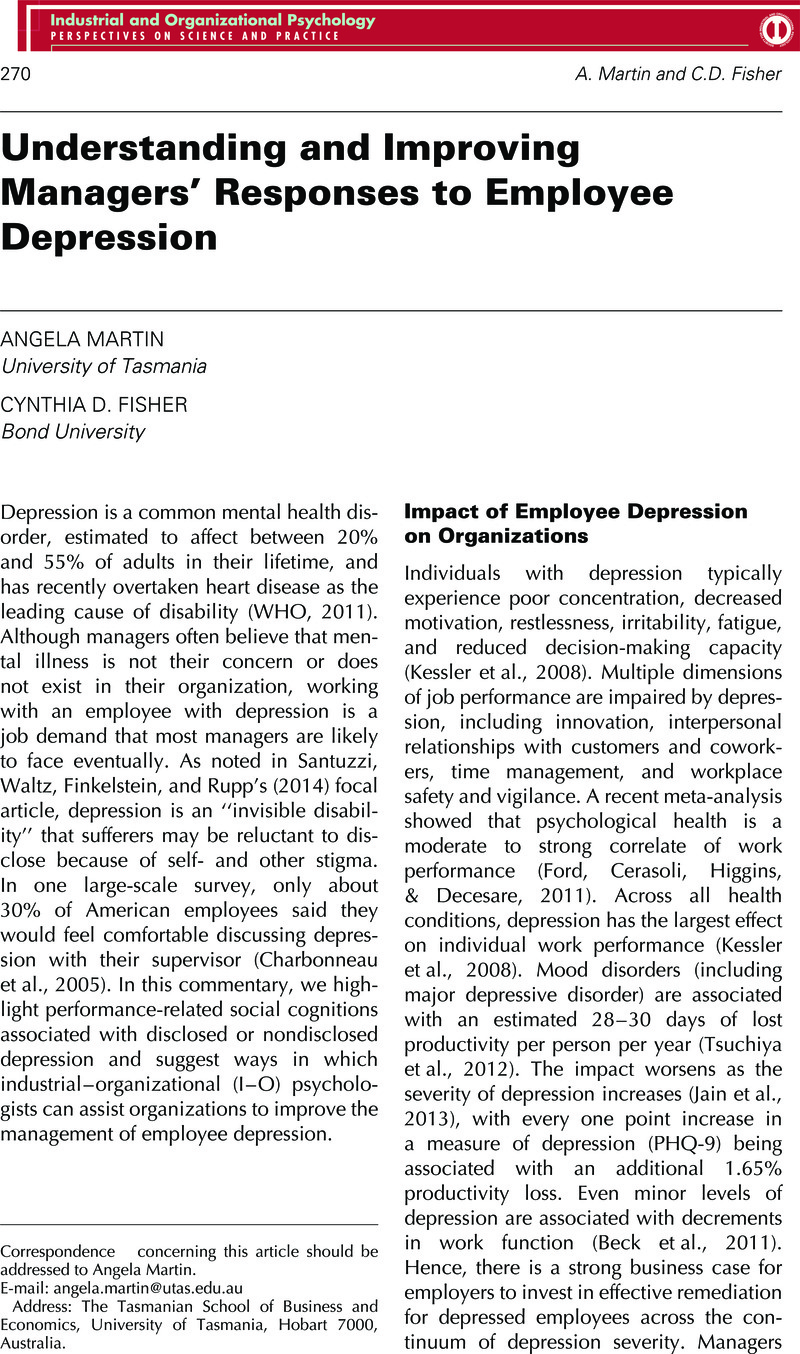Crossref Citations
This article has been cited by the following publications. This list is generated based on data provided by Crossref.
Martin, Angela J.
and
Giallo, Rebecca
2016.
Confirmatory Factor Analysis of a Questionnaire Measure of Managerial Stigma Towards Employee Depression.
Stress and Health,
Vol. 32,
Issue. 5,
p.
621.
Shimazu, Akihito
Oakman, Jodi
Dollard, Maureen F.
and
Nordin, Rusli Bin
2016.
Psychosocial Factors at Work in the Asia Pacific.
p.
361.
Bovopoulos, Nataly
Jorm, Anthony F.
Bond, Kathy S.
LaMontagne, Anthony D.
Reavley, Nicola J.
Kelly, Claire M.
Kitchener, Betty A.
and
Martin, Angela
2016.
Providing mental health first aid in the workplace: a Delphi consensus study.
BMC Psychology,
Vol. 4,
Issue. 1,
Jarman, Lisa
Martin, Angela
Venn, Alison
Otahal, Petr
Blizzard, Leigh
Teale, Brook
Sanderson, Kristy
and
Thompson Coon, Jo
2016.
Workplace Health Promotion and Mental Health: Three-Year Findings from Partnering Healthy@Work.
PLOS ONE,
Vol. 11,
Issue. 8,
p.
e0156791.
Woo, Jong-Min
Tak, Jinkook
Chung, Jinjoo
and
Cho, Ji-Yeon
2016.
The Negative Effects of Job Stress on Individual, Its Family, and Community : Development of the Scale and Its Validation.
Journal of Korean Neuropsychiatric Association,
Vol. 55,
Issue. 4,
p.
432.
Martin, Angela
Hobman, Elizabeth
Howarth, Emma
and
McDonald, Kyla
2016.
Psychosocial Factors at Work in the Asia Pacific.
p.
267.
Birkeland, Marianne Skogbrott
Nielsen, Morten Birkeland
Hansen, Marianne Bang
Knardahl, Stein
and
Heir, Trond
2017.
The impact of a workplace terrorist attack on employees' perceptions of leadership: A longitudinal study from pre- to postdisaster.
The Leadership Quarterly,
Vol. 28,
Issue. 5,
p.
659.
Corbière, Marc
Lecomte, Tania
Lachance, Jean-Philippe
Coutu, Marie-France
Negrini, Alessia
and
Laberon, Sonia
2017.
Stratégies de retour au travail d’employés ayant fait l’expérience d’une dépression : perspectives des employeurs et des cadres des ressources humaines.
Santé mentale au Québec,
Vol. 42,
Issue. 2,
p.
173.
Dawkins, Sarah
Martin, Angela
Kilpatrick, Michelle
and
Scott, Jenn
2018.
Reasons for Engagement.
Journal of Occupational & Environmental Medicine,
Vol. 60,
Issue. 10,
p.
917.
Martin, Angela
Woods, Megan
and
Dawkins, Sarah
2018.
How managers experience situations involving employee mental ill-health.
International Journal of Workplace Health Management,
Vol. 11,
Issue. 6,
p.
442.
Rothermund, Eva
Kilian, Reinhold
Balint, Elisabeth M.
Rottler, Edit
von Wietersheim, Jörn
Gündel, Harald
and
Hölzer, Michael
2019.
Wie bewerten Nutzer das neue Versorgungsmodell „Die Psychosomatische Sprechstunde im Betrieb“?.
Bundesgesundheitsblatt - Gesundheitsforschung - Gesundheitsschutz,
Vol. 62,
Issue. 2,
p.
186.
Martin, Angela
Kilpatrick, Michelle
Scott, Jenn
Cocker, Fiona
Dawkins, Sarah
Brough, Paula
and
Sanderson, Kristy
2020.
Protecting the Mental Health of Small-to-Medium Enterprise Owners.
Journal of Occupational & Environmental Medicine,
Vol. 62,
Issue. 7,
p.
503.
Thisted, Cecilie N.
Labriola, Merete
Nielsen, Claus V.
Jul Håkonsen, Sasja
and
Bjerrum, Merete B.
2020.
Understanding depression as a workplace issue: Clarifying employers’ attitudes to manage employees with depression.
Work,
Vol. 65,
Issue. 4,
p.
857.
Bertilsson, Monica
Klinkhammer, Stephanie
Staland-Nyman, Carin
and
de Rijk, Angelique
2021.
How Managers Find Out About Common Mental Disorders Among Their Employees.
Journal of Occupational & Environmental Medicine,
Vol. 63,
Issue. 11,
p.
975.
Ruiz-Palomino, Pablo
Yáñez-Araque, Benito
Jiménez-Estévez, Pedro
and
Gutiérrez-Broncano, Santiago
2022.
Can servant leadership prevent hotel employee depression during the COVID-19 pandemic? A mediating and multigroup analysis.
Technological Forecasting and Social Change,
Vol. 174,
Issue. ,
p.
121192.
Hultqvist, Jenny
Zhang, Peiran
Staland-Nyman, Carin
and
Bertilsson, Monica
2023.
Managers’ Influence on the Prevention of Common Mental Disorders in the Workplace.
Journal of Occupational & Environmental Medicine,
Vol. 65,
Issue. 12,
p.
1008.
Wilkinson, Krystal
2023.
Maternal (perinatal) mental health and employment: An agenda for research and practice.
Human Resource Management Journal,
Vol. 33,
Issue. 2,
p.
346.
Kalargyrou, Valentini
Sundar, Vidya
and
Jahani, Shiva
2023.
Managers’ attitudes toward employees with depression and organizational citizenship behaviors in the hospitality industry: assessing the mediating role of personality.
International Journal of Contemporary Hospitality Management,
Vol. 35,
Issue. 2,
p.
602.





